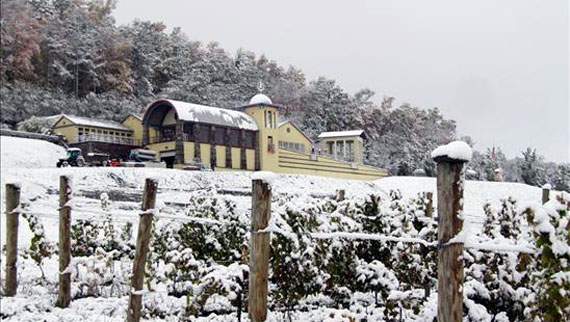
By Evan Dawson, Finger Lakes Editor
Photo, taken this morning from Heron Hill's riesling vineyard, is courtesy of Heron Hill Winery
There is a vital question that will soon be answered in the Finger Lakes: Is it too late for an Indian summer?
Next week, meteorologists expect temperatures to soar back into the mid-60s. But we've been mired in the mid-40s for nearly a week. Grapes still on the vine have been hanging tough, though they haven't been adding much sugar.
To my surprise, I found a wide range of ideas and opinions about what the vines are capable of next week and beyond.
I asked a variety of people in the industry the following: Can the vines still "re-charge," making new sugar for grapes, or will they "shut down" even though there hasn't been a killer frost?
The first grower, who asked not to be identified, said: "Absolutely vines can and will do that. And we need them to do it this year. For us, it's silly to pick varieties like riesling already when there's more development to come. Yes, there's a difference between 55 degrees and 65 degrees and 75 degrees, but the grapes will have a chance to add sugar if the forecast holds up."
John Ingle, owner of Heron Hill Winery and a long-time grape grower at Ingle Vineyard, didn't want to make a declaration one way or the other: "Ask 30 different people and you'll get 30 different answers. The truth is we don't know. We've seen the process hit a wall even without that killer frost you mention. But we're hopeful there's still more time in this season for ripening and sugar development."
But Peter Bell, head winemaker at Fox Run Vineyards, says history has taught important lessons: "I'm not saying it's impossible to re-start sugar synthesis, but I'm saying I've never seen it after a stretch of weather like this. In our view, it's over, and it's time to bring them in. And that's okay. The flavors for riesling in particular are just beautiful."
Bell explains that allowing grapes to hang longer might lead to more sugar concentration through dehydration, but longer hang-time of course brings more risk and more variables. "This is a challenging vintage, but by no means impossible," he says, adding, "There's quite a difference between one sub-50 degree day and a stretch of five or ten. We accept the conditions and now it's our job to make outstanding wine."
We'd love to hear from more growers and industry professionals. Bell and Ingle stressed that their views come from their own experiences, and they respect their colleagues who might disagree about grape development. Other growers were reluctant to attach their names to any statements, explaining that they don't want to offend colleagues. It is never an easy call on when to pick. For those who have decided to let grapes hang, there will be a surge in temperatures, and they're hoping their bet will pay some late-October dividends.
UPDATE: It's important to note that each grower/winemaker is going to have to assess the picking schedule based on each individual site. There are huge differences. Hard frost affected one parcel of John Ingle's vineyard, shutting it down, while other parts closer to Canandaigua Lake are hanging in stronger. One site on Seneca Lake might have been affected by frost and cold, while another might benefit from a warmer mesoclimate. So certainly there is no "one-size-fits-all" pronouncement to make on the subject. As we get more thoughts from growers about whether they plan to pick now or let the grapes hang, we'll add them.
SECOND UPDATE: We heard from Phil Davis, grower for Damiani on Seneca Lake. Davis is letting his grapes hang. He wants to allow acids to drop in some cases, and he also expects to see some more photosynthesis. Dehydration is something Davis hopes to see as well, and he plans to be patient; Davis figures that he lets his grapes hang longer than most Finger Lakes growers in a typical vintage.
